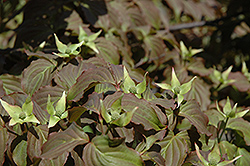It's all about ...
plants

Ed Mezitt Chinese Dogwood
Cornus kousa 'Ed Mezitt'
Height: 25 feet
Spread: 25 feet
Sunlight:
![]()
![]()
Hardiness Zone: 5a
Other Names: Kousa Dogwood
Description:
Unique for its leaves that emerge burgundy and then remain bronze until its flowers appear; this broad spreading dogwood has wide overlapping creamy bracts that last for several weeks followed by raspberry-like fruit and great orange fall color
Ornamental Features
Ed Mezitt Chinese Dogwood features showy clusters of shell pink flowers with shell pink bracts held atop the branches in late spring. It has attractive dark green deciduous foliage which emerges burgundy in spring. The pointy leaves are highly ornamental and turn an outstanding orange in the fall. It features an abundance of magnificent crimson berries from early to mid fall. The peeling gray bark adds an interesting dimension to the landscape.
Landscape Attributes
Ed Mezitt Chinese Dogwood is a multi-stemmed deciduous tree with a stunning habit of growth which features almost oriental horizontally-tiered branches. Its average texture blends into the landscape, but can be balanced by one or two finer or coarser trees or shrubs for an effective composition.
This is a relatively low maintenance tree, and should only be pruned after flowering to avoid removing any of the current season's flowers. It is a good choice for attracting birds to your yard. It has no significant negative characteristics.
Ed Mezitt Chinese Dogwood is recommended for the following landscape applications;
- Accent
- Shade
Planting & Growing
Ed Mezitt Chinese Dogwood will grow to be about 25 feet tall at maturity, with a spread of 25 feet. It has a low canopy with a typical clearance of 1 foot from the ground, and is suitable for planting under power lines. It grows at a medium rate, and under ideal conditions can be expected to live for 40 years or more.
This tree does best in full sun to partial shade. It does best in average to evenly moist conditions, but will not tolerate standing water. It is very fussy about its soil conditions and must have rich, acidic soils to ensure success, and is subject to chlorosis (yellowing) of the foliage in alkaline soils. It is somewhat tolerant of urban pollution, and will benefit from being planted in a relatively sheltered location. Consider applying a thick mulch around the root zone in winter to protect it in exposed locations or colder microclimates. This is a selected variety of a species not originally from North America.
This plant is not reliably hardy in our region, and certain restrictions may apply; contact the store for more information.
